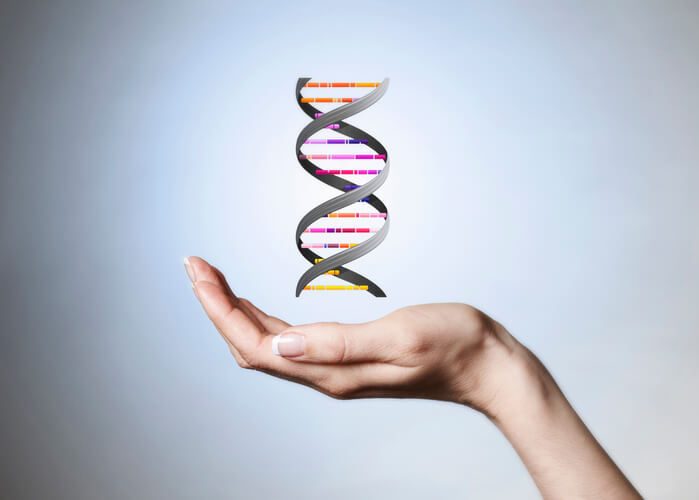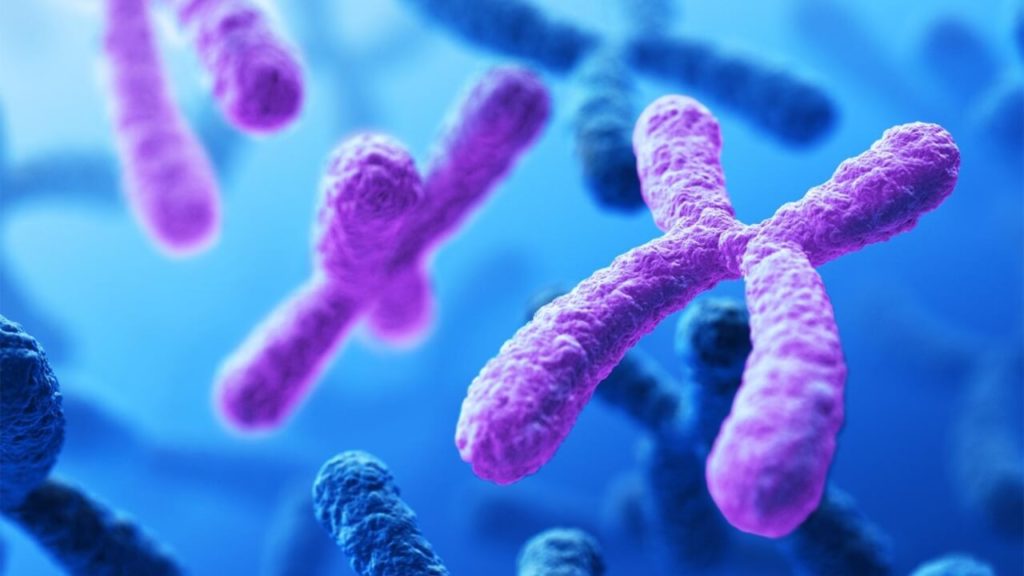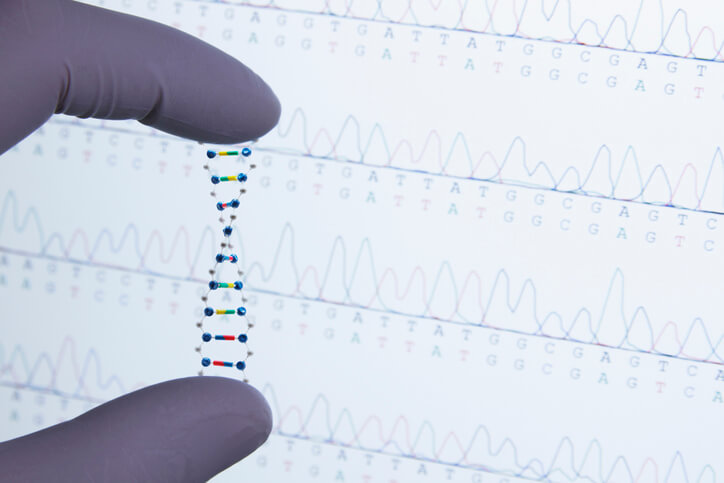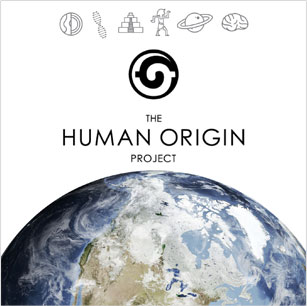Why do you have your mother’s eyes and your father’s nose?
DNA is the imprint of all life on earth. Behind every living creature is the story of DNA. Genetics is the science of the history and the future of the human origin story.
You might think that genetics is too tricky to learn, but that is just not true. For many years, before modern science, people have observed how life seems to pass certain traits from one generation to the next. It is the simple way parents pass on their cellular information to offspring.
Even before the way DNA works was discovered, genetics was used to predict traits in offspring. Breeding of domestic plants and animals had shown that useful traits could be replicated. Things like speed in horses, strength in oxen, and larger fruits in crops were created by controlled mating.
It was long believed that you would inherit traits equally from parents. However, children often look more like one parent than the other, most offspring seem to take traits of both parents. Genetics was long thought to be a ‘dilution’ of the traits of parents.
As a result, it was unknown how to predict the outcome of a cross between two parents. The science of biology, DNA, genetics and how we inherit our genes is the science of these mechanisms. Modern genetic medicine, gene therapy, and agricultural science are based on how DNA works.
In this three-part, simple guide, we will discuss the three parts of simple human genetics and DNA.
What You will Learn:
Part I: What does genetic inheritance mean?
Part II: How chromosomes and sex are determined
Part III: X-Linkage and Sex Inheritance
Part I: What does genetic inheritance mean?
Up until the turn of the 20th century, genetics was vaguely understood as a dilution of traits inherited from parents. Forty years before this, the father of modern genetics, Gregor Mendel (1822-1884) laid the foundation for a massive leap in human understanding. However, it was not until the 1900s that his work was taken seriously. He died before hearing his theories were indeed correct.
An Austrian Monk, Mendel’s work focused on how pea plants produced traits through a series of famous experiments. He recorded the reproduction and observed generations of the plants, their traits and how they passed on.
Mendel ‘s ‘pea plant experiments’ took eight years (1856-1863). They provided a simple, easy and quick model to control and measure the inheritance through many generations. During this time, Mendel grew over 10,000 pea plants, keeping track of the number of offspring and type.
He cross-fertilized pea plants that had distinctly opposite traits. Tall with short, smooth with wrinkled, those containing green seeds with those containing yellow seeds.
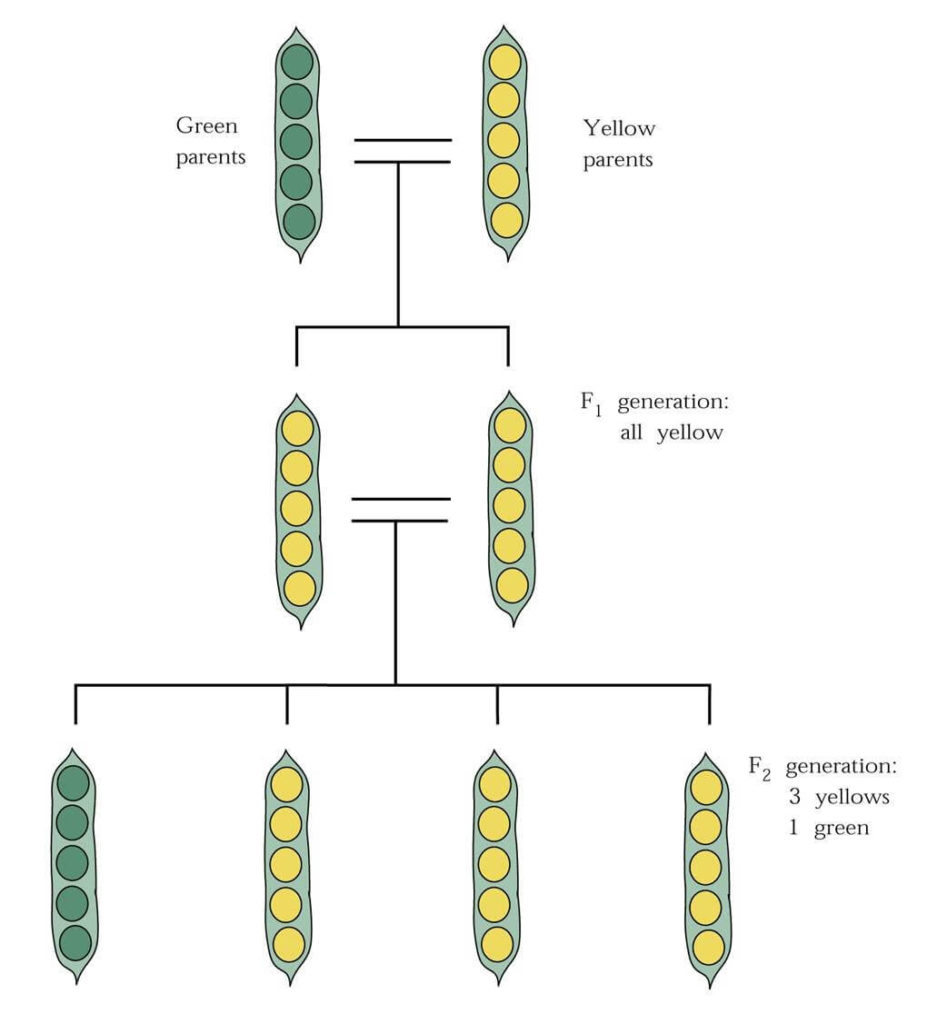
Pea plant traits were the basis of Mendel’s 8-year genetic experiments. Source
He published his results in 1865.
Mendel’s theory of genetics was:
“Inheritance involves the passing of discrete units, or genes, from parents to offspring.”
Mendel’s pea plant work would transform the breeding of crops and farm animals from an art to a science. It would also help the birth of the science of biology, with the basis of modern DNA and genetic theory.
How are genes passed down?
Genes are the instructions for life to make cells. Nearly all living creatures, depend on DNA and genetics to allow cells to be created from parents.
To understand this, we need to learn four simple terms. They describe how genes are passed from one generation to the next.
DNA carries genes as information:
1) The Gene
A section of DNA that specifies the construction of a protein. Each gene carries instructions that determine your features, such as eye color, hair color, and height.
2) An Allele
One form of the gene may specify green peas, another yellow peas. The various forms (or alternatives) of a gene are called alleles.
For example: one form of the gene may specify green peas, another yellow peas. The various forms (or alternatives) of a gene are called alleles
3) The Genotype
Offspring will inherit two different genes from their parents.
The genetic makeup of the individual includes the genes and the different alleles (can be for the whole genetic makeup, or for a single gene pair).
4) The Phenotype
We call the observable appearance of a trait the phenotype.
It is the result of the genes, passed from parents, and then expressed as a trait. The allele is the trait expressed. For example A green pea.
For example:
Gene: G (green) y(yellow)
Allele: Color
Genotype: Gy
Phenotype: Green
In the next section, we will discuss why the pea is green and not yellow.
What are Mendel’s laws of inheritance?
Now we understand what a gene, an allele, and their expression are called. Next is to understand how they all work.
Mendel’s experiments allowed him to create three laws of inheritance. They describe how DNA and genes with different alleles work to create certain traits (the phenotype).
He started with parents of known genetic background — to provide a baseline to compare patterns of inheritance in the resulting offspring.
By counting the numbers of individuals showing the various traits in successive generations of offspring he found three laws or patterns.
These are Mendel’s three laws of inheritance:
1) The Law of Segregation
Each inherited trait is defined by a gene pair. For example, the Green (G) and yellow (y) genes are broken up as a parent mates. These create sex cells (called gametes) and pass one gene along.
Offspring, therefore, inherit one genetic allele from each parent when sex cells unite in fertilization.
2) The Law of Dominance
An organism with alternate forms of a gene will express the form that is dominant.
If Yellow (Y) is dominant and Green is recessive (g), the genotype will be Yg. The phenotype will be yellow.

Dominant genes will express when joined together with recessive genes. Source
3) The Law of Independent Assortment
Color is one type of gene, living creatures have many genes carried by their DNA.
Genes for different traits are sorted separately from one another and are not dependent on each other.
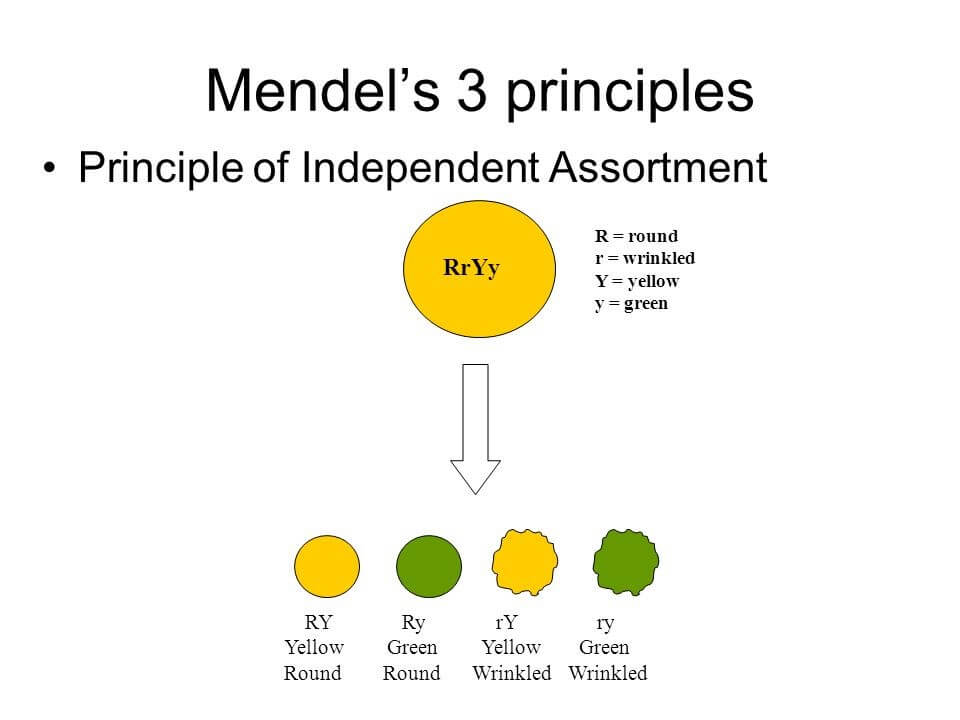
Mendel’s Law of independent assortment shows how separate genes are carried without influencing each other.
Here’s an example showing color and fur type of certain dog breeds.
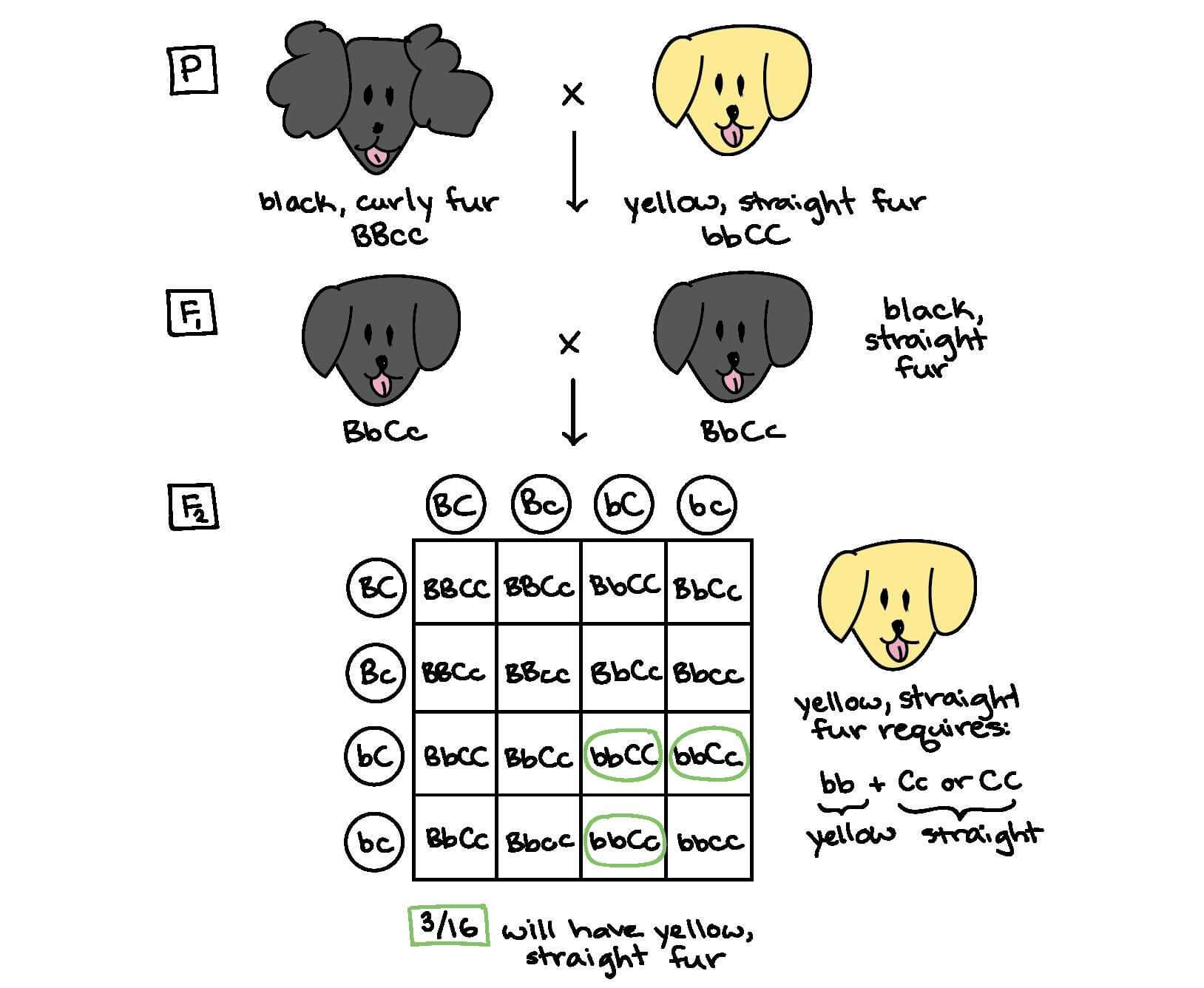
Mendel’s third law of independent assortment.
Conclusion:
Mendel had outlined the basic laws of DNA genetics. These principles define the ways that genes work.
He had not, however, any idea of the molecular basis of inheritance.
Part II: Chromosomes, Meiosis, and Sex Determination
Pea plants provide a model of how genes work in a very simple way. However, things get more complex in larger organisms.
Mendel’s work may have been initially ignored because it was missing the molecular basis of genetics.
In 1902, two scientists, Boveri, and Sutton, who had never seen Mendel’s work, began their own research. Studying sea urchins and grasshoppers, they each noticed that chromosomes seemed to behave to Mendel’s Three Laws of Inheritance.
They were the first to deduce that chromosomes were the cells that contain genes. It would allow them to identify a physical cell that was parents passed to offspring and was described by Mendel.
It was called the Boveri-Sutton chromosomal theory.
What is a chromosome simple definition?
In the nucleus of each cell, the DNA molecule is packaged into thread-like structures called chromosomes. Each chromosome is made up of DNA tightly coiled many times around proteins called histones that support its structure.
Scientists carefully documented the behavior of chromosomes during cell division (mitosis), using dyes to make them visible.
Chromosome divisions, mitosis & meiosis.
Mitosis is a type of cell division where two identical daughter cells are created.
In complex life, (eukaryote cells) chromosomes use a form of replication called meiosis.
What happens to chromosomes during meiosis?
Meiosis is a type of cell division that results in four daughter cells. Each with half the number of chromosomes of the parent cell (a gamete).
The three steps of meiosis are:
- Each chromosome copies itself and the duplicates line up at the “equator” of the cell.
- Duplicate copies of each chromosome are then pulled toward opposite poles.
- Finally, the cell splits at the equator, producing two new cells with identical sets of chromosomes.
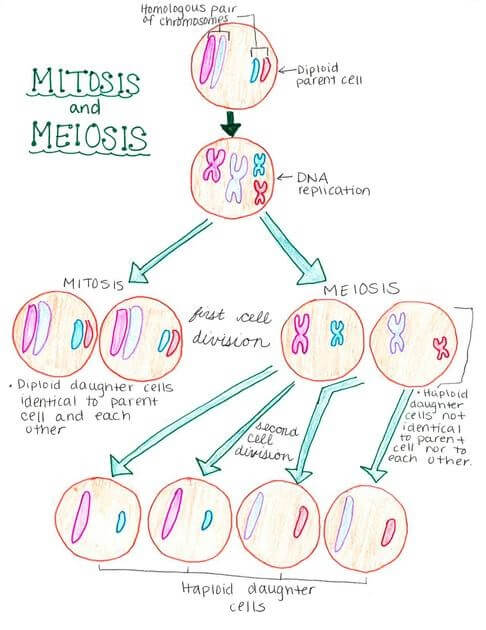
During mitosis, two identical daughter cells are made. During meiosis, chromosomes split to create four daughter cells. Source
How many human chromosomes are there during meiosis?
Human DNA contains 46 chromosomes (23 pairs).
During meiosis, a cell splits its chromosomes splits to reduce from 46 to 23 chromosomes.
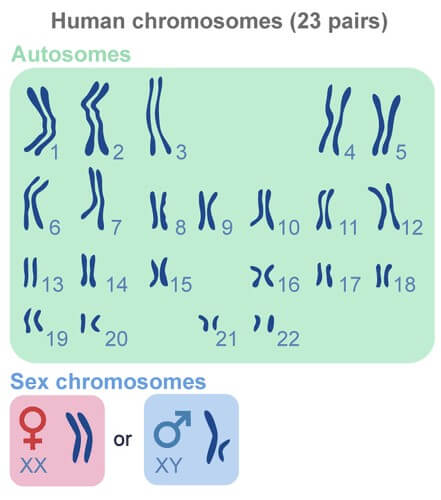
Humans have 23 pairs of chromosomes or a total of 46. Source
How is sex determined and inherited?
Out of the 23 human chromosomes, there are two sex chromosomes X & Y.
Unlike the other chromosomes, they are different sizes.
X is female, Y is male. Sex is determined in humans by the XX/XY system. It is found in most mammals.
Male sperm (gametes) contain two types of sex chromosomes (XY).
Female eggs (gametes) contain two of the X sex chromosomes (XX).
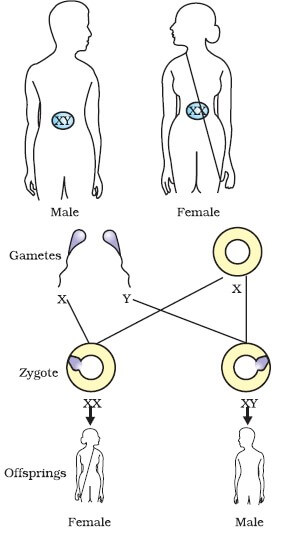
How sex is determined in human genetics. Source
Human sex is determined by the presence or absence of a Y chromosome. However, it also depends on a gene, called the SRY gene found on the Y chromosome.
Once the SRY gene is activated, cells create testosterone that builds the male reproductive system.
In normal XX embryos, cells secrete estrogen, which drives the body in a female cell pathway.
What is a gamete?
A gamete is a sex cell (sperm or egg in humans) that contains only one set of different chromosomes. It equates to half the genes necessary to reproduce an offspring.
They join with other gametes (egg joins with sperm) to form a full set of genetic material.
Part III: X-Linkage and Sex Inheritance
The discovery of the chromosome helped to reveal that DNA and genetics had more and more layers. Simple Mendelian laws, for example, don’t explain why certain traits skip generations. They also don’t explain why some traits show up more in boys than in girls.
In 1908, Thomas Hunt Morgan performed a two-year long experiment on fruit flies. His work discovered the model of X-linkage and sex inheritance.
Firstly, it took two years for Morgan to find a white-eyed male. He knew this had a mutated eye color gene that he could test in further experiments.
He then crossed the white-eyed (mutant) male with red eye (wild-type) females.
After two years he found white-eyed males. They were only males.
Morgan deduced that the inherited trait must travel on a sex-determined chromosome. He had discovered X-linked inheritance.
Here’s how X-linked inheritance works:
X–linked recessive inheritance is where a mutation passes on a gene on the X chromosome. It’s usually found in males, which only express one X chromosome (XY). It also expresses in females who carry both mutant X chromosomes (homozygous for the gene mutation).
Here’s what the fruit fly example shows.
Generation 1 (F1)
Then in the next generation.
Generation 2 (F2)
*There is also X-linked dominant inheritance, which is much rarer, but displays in females.
How is DNA inherited from each parent?
Because our parents hold different DNA, certain traits are passed by mothers or fathers.
Sex-linked traits are associated with genes found on sex chromosomes (X and Y).
As the female X-chromosome is larger, X-linked traits are more common than Y-linked traits. An example of a sex-linked trait is red-green colorblindness, which is carried on the X-chromosome.
Because males only have one X-chromosome, they have a higher chance of having red-green colorblindness.
Recessive sex-linked traits are much more common in men because they only need one affected X chromosome.
Another example of X-linked sex traits is hemophilia.
Let’s look at the genotype.
XhX – Woman no hemophilia
XhY – Man with hemophilia
What DNA is passed down from the father?
A father either passes a Y chromosome to their son or an X chromosome to a daughter.
In this case, the DNA of the unaffected father is passed down. The offspring don’t inherit the condition from their father.
Extra or missing chromosomes
Another type of sex-linked disorder has too many or too little chromosomes.
Having extra or missing chromosomes is not usually a good thing. In fact, for most chromosomes, having an extra or missing copy is lethal to humans (causing an embryo to die early in development).
Human females have two X chromosomes (XX), while human males have just one (XY). Why doesn’t it cause problems for men to have just one copy of the X chromosome, while women have two?
The most common form of Down syndrome is known as trisomy 21. It is a condition where individuals have 47 chromosomes in each cell instead of 46.
Trisomy 21 is caused by an error in cell division called nondisjunction. This leaves a sperm or egg cell with an extra copy of chromosome 21.
Conclusion:
- The sex chromosomes carry Sex-linked traits
- In recessive sex-linked traits, the mother is usually the silent carrier
- Affected individuals are more often males due to one X linked chromosome
- Missing or extra chromosomes can produce genetic disorders.
Do you have any questions regarding the laws of inheritance and DNA?
Leave them in the comments section below.
Further reading:
- https://www.nature.com/scitable/topicpage/gregor-mendel-and-the-principles-of-inheritance-593
- https://www.nature.com/scitable/topicpage/developing-the-chromosome-theory-164
- https://www.khanacademy.org/science/high-school-biology/hs-molecular-genetics/hs-discovery-and-structure-of-dna/a/hs-dna-structure-and-replication-review
- https://www.researchgate.net/publication/233334824_Tinkering_with_meiosis?_sg=Eg5cYYDoysHt4VhJxTt9tlcZmuSvVygagL6UNHYkZnz6Zym635JOmydBmaOwjvqujolTzvUC0g


 DNA obeys a simple set of laws to of pass inherited information from parents to offspring.
DNA obeys a simple set of laws to of pass inherited information from parents to offspring. 